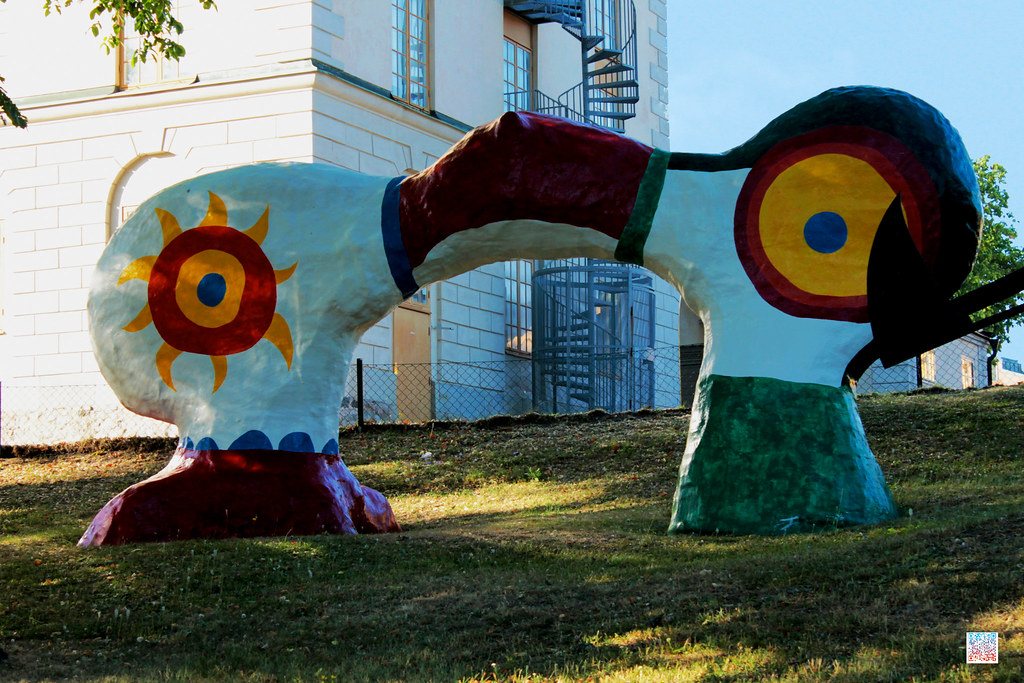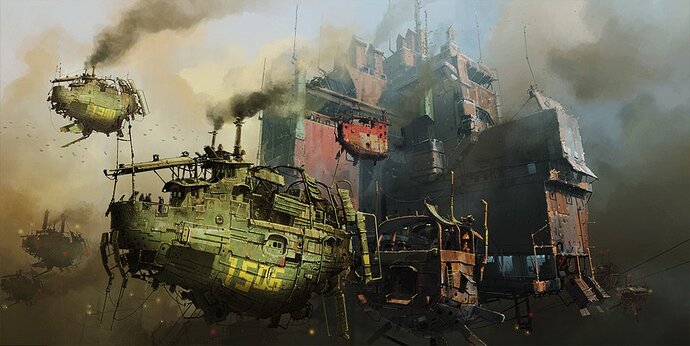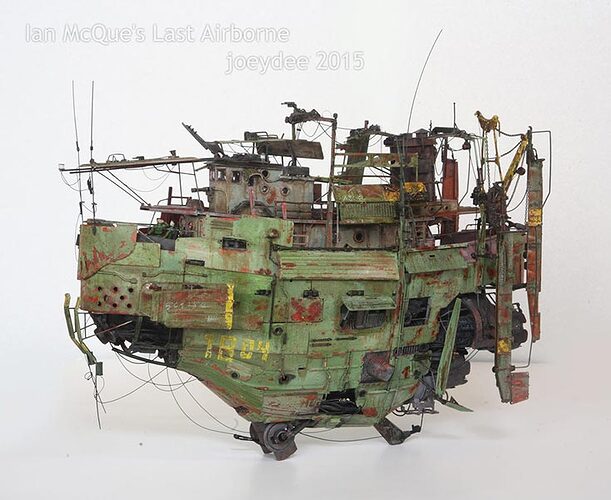Nope, I’m not listening! 


Is someone castrating a cat?
Geez…those Jalapenos she had for lunch must have been potent!
Upon further thought, I found myself disagreeing with myself (not that strange given how strange I am…).
If this is art:
(and how can it not be?) Then logically this must be too:
Full build report:
Regards,
M
Good heavens…
As for the Eye of the Beholder: Put a sword+1 in there! Or a battle axe ![]()
As for “is it art”: That actually can be an important legal question. If the picture of the steam engine is art - it has legal protection against a 1:1 copy. If something is art - in some countries it can touch/include subjects and elements that are otherwise illegal
In general I would consider modeling a craft not an art. Some highly skilled modelers do produce stuff that is not easily (if at all) reproduceable by others even if they put learning time in the hobby (A component of “real Art” for me is that it takes some “special touch”). Most of us do work that is reproduceabel, Not by everyone but by everyone who goes through the “training”. That is craft for me. High end craft in some cases (And craft produces beautiful results - churches are craft not art) but craft.
For me that is ok, the few artists I met where all a tad strange… ![]()

Where does that put the artist who gets his/her art forged by someone?
Does the forgery turn the art into mere craft?
Does the forgery elevate the forger (a crafty criminal) to the status of real artist?
Edit: What it wanted to say is that the criteria ‘being possible to reproduce’ might not be ideal when it comes to differentiating between art and craft.
Art forged in the same method as the original requires artistic talent. That doesn’t make it ethical.
IP law is tricky in the USA…an artist can get into trouble if the artist is believed to rip himself off on occasion…never mind someone else ripping off the artist’s style…
The Time John Fogerty Was Sued for Ripping Off John Fogerty
Short version…
Fantasy sued Fogerty for copyright infringement, claiming that “The Old Man Down the Road” was essentially the music to “Run Through the Jungle” with new words. The case was litigated through a jury trial, and the jury found in Fogerty’s favor, rejecting the claim of infringement.
Well, considering copies, forgeries and infringements (by the artist of himself and by others), we have many examples dating back to the Renaissance (and probably earlier that I have no idea about).
Look at Titian’s “Venus and Adonis” which Titian, himself, copied and sold to different patrons (in different canvas sizes). The profit motive was strong as was the demand for production by his patrons. Still, each copy is considered to be a masterpiece, today.
(Heck, no need to go that far back, just look at Edvard Munch’s “The Scream,” which he produced in several slightly different versions. One artist, multiple copies of the same work, all of which are not only considered art, but also masterpieces. However, sticking to the “old masters”…)
Then there’s Raphael’s “Marriage if the Virgin” - the original - and Perugino’s copy of the same painting - painted almost contemporaneously and sold to another patron simply to satisfy the demand for Raphael’s work. Again, two copies of the same painting, done by different hands, nearly identical in composition, and both of which are considered masterpieces today.
When thinking about “talent” as a criteria as to whether some work is or is not “art,” consider the entire Renaissance “workshop-studio” production system.
The “artist” (or “master”) directed some number of “apprentices” to do the work of “drafting” up the works while the master merely added some “final touches,” usually just enough to satisfy the commission for “his work.” The demand for works by various patrons created a system to produce numerous works, many of which may have only been nominally done by the artist taking the commissions. This was very common.
(People today will look at an Andy Warhol print, of which there might be hundreds of copies, and still declare it a “work of art.” Never touched by the artist or perhaps only ever signed by him, but still not the original and not “created” by his hand.
Clearly uniqueness and “un-copied” are not criteria for a work to be “art” or not. There there’s Picasso…)
The vast majority of these workshop / studio “backup artists” are unknown to history, but the works created by their “masters” are indeed, still well known and considered “masterpieces.”
The question, to me at least, is that if a copy of a work can still be considered “art,” then what is it that is inherent in that work, itself, that confers that distinction upon it? Is it some expressive quality contained within the nature of the work that makes it “art” no matter how many copies of it exist?
The same question goes for work that was not, at lest in its entirety, created by the “famous” artist. Was it elevated to the status of “art” by the few brush strokes (perhaps a signature) of the “master” or through the work of the apprentices? Or is there more to it than just the effort and talent (or lack thereof) of the creators? Is it art because of something that is contained within the expressive nature of the work in spite of the number of hands that created it or their individual talent?
Some musical compositions are considered “art,” but where does that art exist? If the composition is never performed, is it still art? Is the collection of written lines and notes on paper the art, or is the art created when the music performed and perceived by the audience? Certainly the composition exists within the composer’s mind, but is his imagination “art” without someone experiencing the actual music?
Another approach, disdained by many, could be “beauty”
OK, OK, we all know that beauty is in the eye of the beholder,
but,
would there be a difference if a large group of “beholders” considered something beautiful
versus if only a select elite (OK, I’m being provocative) considered it beautiful?
If kitsch is considered beautiful by many and universally puked upon by the acknowledged critics, could it be art or is it still only kitsch?
Who is bestowed the right to make the call between art and not art?
Some listen to country music, others stick to jazz. Is both of them art, only one or none?
Some want to see what a painting represents, others consider figurative art to be less artistic than “real” art which doesn’t resemble anything.
Modern art

Click image and go right arrow in the photostream. Art? I will not make the call on that. Not my style but who am I to judge …
Either there was a lot of creativity involved or “acid” had a role in creating this.
Creativity or acid?
If I build and paint a tank according to a given paint scheme I would not call it art (it isn’t, period)
Others build and paint and put some creative content into the finished object, this is probably art.
An acknowledged art critic would probably say that it is not art.
Someone once said that art is something produced by an accepted artist.
If you’re not a member of the “club” your work is at best “craft”
I’ve seen works like this before. In my neck of the woods it’s known as dreck
dreck as in a German word? In that case I would tend to agree …
Still art though, according to those who know about art …
German/yiddish.
You’d be surprised how much dreck is on display at some of the highly regarded art museums in NYC.
I do appreciate modern art but a series of works that are each comprised of a custodians push broom attached to a canvas and the whole thing painted battleship grey… ain’t art to me. IIRC that was at the Metropolitan Museum of Art.
I would venture to say that Calvin et Hobbes is a foremost example of true art.
The changing nature of tastes and style biases (both for and against) are why it seems to me that true nature of art is in its capacity to communicate a mainly emotional message between the creator and the audience.
Beauty is certainly in the eye of the beholder, but what those beholders consider beautiful is ever changing and variable. What was considered beautiful yesterday may not be so today, and even today, what is considered beautiful is absolutely universal. (Allowing that beauty, in this case, can be understood to represent a range of emotions.)
However, sharing a mutual aesthetic or emotional message between the artist and the audience is an immutable idea. The media, the process, and the style may change, but the need to share one’s emotive messages through means and media outside of normal communication remains constant.
As long as the artist and his audience can connect and share their mutual appreciation and understanding of the subject, does it matter how large that audience is or how narrowly appealing the subject is?
Yesterday’s magazine cover illustrator (for example, Norman Rockwell) is today’s highly regarded artist. What was once “yard garbage” is today’s “primitive artwork” commanding high prices and greatly sought after. At one time, the great and famous “impressionists” were all considered immature and childish frauds, and their work was excoriated by the mainstream art “influencers” of their day.
It’s always been the discovery of the emotive message of the artist within these works that has elevated them to some future status as “art.” However, that message was always there. It was imbued into the work when it was created, and if it always existed, wasn’t that piece of work then always “art”?
This is a very thought provoking topic, first let me say “excoriate”?, man that’s a word you don’t see every day!, but It seems to me the real question in the OP was " . . are there subjects that can’t be tolerated?" inspired by a diorama of the gas chambers used for mass euthanasia (murder) in WWII Nazi Germany. At first thought I was a bit appalled by the idea someone would model that scene but then I began to consider, what about a model of the Atomic bomb “Fat Man”?, think of the hundreds of thousands that were literally vaporized from that single weapon, in fact all of our subject matter as far as AFV’s are concerned, are weapons of destruction, one of my convictions as a modeler is not to model ANYTHING from the Nazi Regime but does that make my beliefs more morally acceptable than someone else who has no problem with it? I build tanks and AFV’s from the Vietnam Conflict that caused horrendous suffering, a canister round from an M551 Sheridan, I don’t even want to think about it. Tough stuff this . . . I personally think it’s in bad taste to model or pose soldiers in a diorama with bloodied limbs or torsos with entrails splayed about but it is a part of an illustration of an historical occurrence, no different than modeling Count Dracula or Vampyra with blood trickling down their chin. Is our hobby or at least the completed models art?, that would depend on the beholder so to speak, recently here on the forum there have been a couple of scratch built models that, to me at least, are nothing less that finely crafted art. I guess we each have our preferences as to what we appreciate and as modelers we usually follow an unspoken decorum, conscious of the sensibilities of those who may view our creations. I hope the work my hobby produces doesn’t offend any one but there’s always that risk.
Cajun 
ummmm
the Hamburg firestorm maybe?
the bombing of Dresden?
Modelling German railroad engines or waggons (used to transport people to the concentration camps) ?
Civilian cars? Lots of deaths every year …
We choose to not think about the loss of lives connected to the various objects and focus on the modelling instead.




